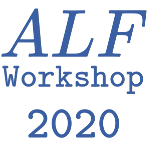Timetable
07.10.2020, 14:00 -- Miklós Werner
07.10.2020, 14:30 -- Joel Hutchinson
08.10.2020, 10:00 -- Tarun Grover
08.10.2020, 14:00 -- Izabella Lovas
08.10.2020, 14:30 -- Natanael Costa
Abstracts
Title: Matrix product state simulations with general non-Abelian symmetries
Speaker: Miklós Antal Werner - Budapest University of Technology and Economics
Slides: ALF2020_slides1-Miklos_Werner.pdf
Recording: Contr_Talks-1-Miklos_Werner.mp4
Abstract:
We introduce the notion of non-Abelian tensors, and use them to build a general non-Abelian matrix product state (NA-MPS) ansatz. We construct a non-Abelian time evolving block decimation (NA-TEBD) scheme that uses an arbitrary number of Abelian and non-Abelian symmetries. Our approach increases the speed and memory storage efficiency of matrix product state based computations by several orders of magnitudes, and makes large bond dimensions accessible even on simple desktop architectures. We demonstrate our approach by studying post-quench dynamics in the repulsive SU(3) Hubbard model. We determine time evolution of various local operators and correlation functions and find that interactions turn algebraic charge relaxation into exponential, and suppress coherent quantum oscillations rapidly.
Title: Fractional topology from entanglement
Speaker: Joel Hutchinson - l'Ecole Polytechnique
Slides: ALF2020_slides2-Joel_Hutchinson.pdf
Recording: Contr_Talks-2-Joel_Hutchinson.mp4
Abstract:
In recent years, rising interest in topology has coincided with advancing quantum science and technology. This fortunate circumstance allows for the direct observation of the Chern number, a measure that distinguishes topological phases. For one spin-1/2 particle, this number is known to be an integer equal to 0 or 1. In this talk, I propose models of interacting spins with applied magnetic fields acting on the Poincaré-Bloch sphere to reveal a new class of topological energy bands with rational-valued Chern numbers for each spin, measurable through the magnetizations at the poles. The mechanism behind this fractional topology is a product state at the north pole and a maximally entangled state at the south pole. We illustrate a precise protocol in time to reveal the spin dynamics which reflects the physics associated with quantum interferometry effects in surrounding energy bands. We will also see a correspondence between the two-spin system and a topological bilayer model on a honeycomb lattice, which describes semimetals with a nodal ring encircling a region of entanglement. These models provide a new bridge that links topology and entanglement with direct applications in quantum dynamics, light-matter coupling and transport properties.
Title: Simulatable models of non-Fermi liquids and nodal superconductivity.
Speaker: Tarun Grove - UCSD
Slides: ALF2020_slides3-Tarun_Grover.pdf
Recording: Contr_Talks-3-Tarun_Grover.mp4
Abstract:
The fermion sign problem often stymies exploration of strongly correlated quantum systems. Recently, new ideas have emerged on how to construct "designer Hamiltonians" which do not suffer from the sign problem, while still hosting highly entangled phases of matter. In this talk, I will present results on two new directions: (a) A model of competing antiferromagnetism and nodal d-wave superconductivity. (b) Models of non-Fermi liquids in Kondo lattice systems. In both cases, the phase diagram hosts interesting critical phenomena as well, and I will also discuss field-theoretic approaches to understand the corresponding universal quantities.
arXiv 1807.08202, 2005.10278 and 2009.06644.
Title: Quantum Coulomb glass on the Bethe lattice
Speaker: Izabella Lovas - TU Muenchen
Slides: ALF2020_slides4-Izabella_Lovas.pdf
Recording: Contr_Talks-4-Izabella_Lovas.mp4
Abstract:
We study the Coulomb glass emerging from the interplay of strong interactions and disorder in a model of spinless fermions on the Bethe lattice, in the limit of infinite coordination number. By combining continuous time quantum Monte-Carlo simulations with self-consistent diagrammatic perturbation theory, we find that strong interactions induce a metallic Coulomb glass phase with a pseudogap structure at the Fermi energy. Quantum and thermal fluctuations both melt this glass and induce a disordered quantum liquid phase. We obtain the complete phase diagram of the electron glass, and characterize its dynamical properties in the replica symmetric quantum liquid phase, as well as in the glassy phase in the presence of full replica symmetry breaking. The spectral function displays an Efros-Shklovskii pseudogap upon decreasing temperatures, but the density of states remains finite at the Fermi energy due to residual quantum fluctuations. Our results bear relevance to the metallic glass phase observed in Si inversion layers.
Preprint: arXiv:2009.02320 (2020).
Title: Phase diagram of the two-dimensional Hubbard-Holstein model
Speaker: Natanael Costa - Scuola Internazionale Superiore di Studi Avanzati
Slides: ALF2020_slides5-Natanael_Costa.pdf
Recording: Contr_Talks-5-Natanael_Costa.mp4
Abstract:
The electron–electron and electron–phonon interactions play an important role in correlated materials, being key features for spin, charge and pair correlations. Thus, here we investigate their effects in strongly correlated systems by performing unbiased quantum Monte Carlo simulations for the Hubbard-Holstein model at the half-filling of 2D lattices. Starting with the square lattice, we study the competition and interplay between antiferromagnetism (AFM) and charge-density wave (CDW), establishing its very rich phase diagram. In the region between AFM and CDW phases, we have found an enhancement of superconducting pairing correlations, favouring (nonlocal) s-wave pairs. Similarly, by performing careful finite-size scaling analysis, we identify semimetal-to-insulator quantum critical points, and determine the behavior of the AFM and CDW phase transitions in the honeycomb lattice, investigating also its behavior for different phonon frequencies. Our findings represent a complete description of the model, and may shed light on the emergence of many-body properties in such a systems.


